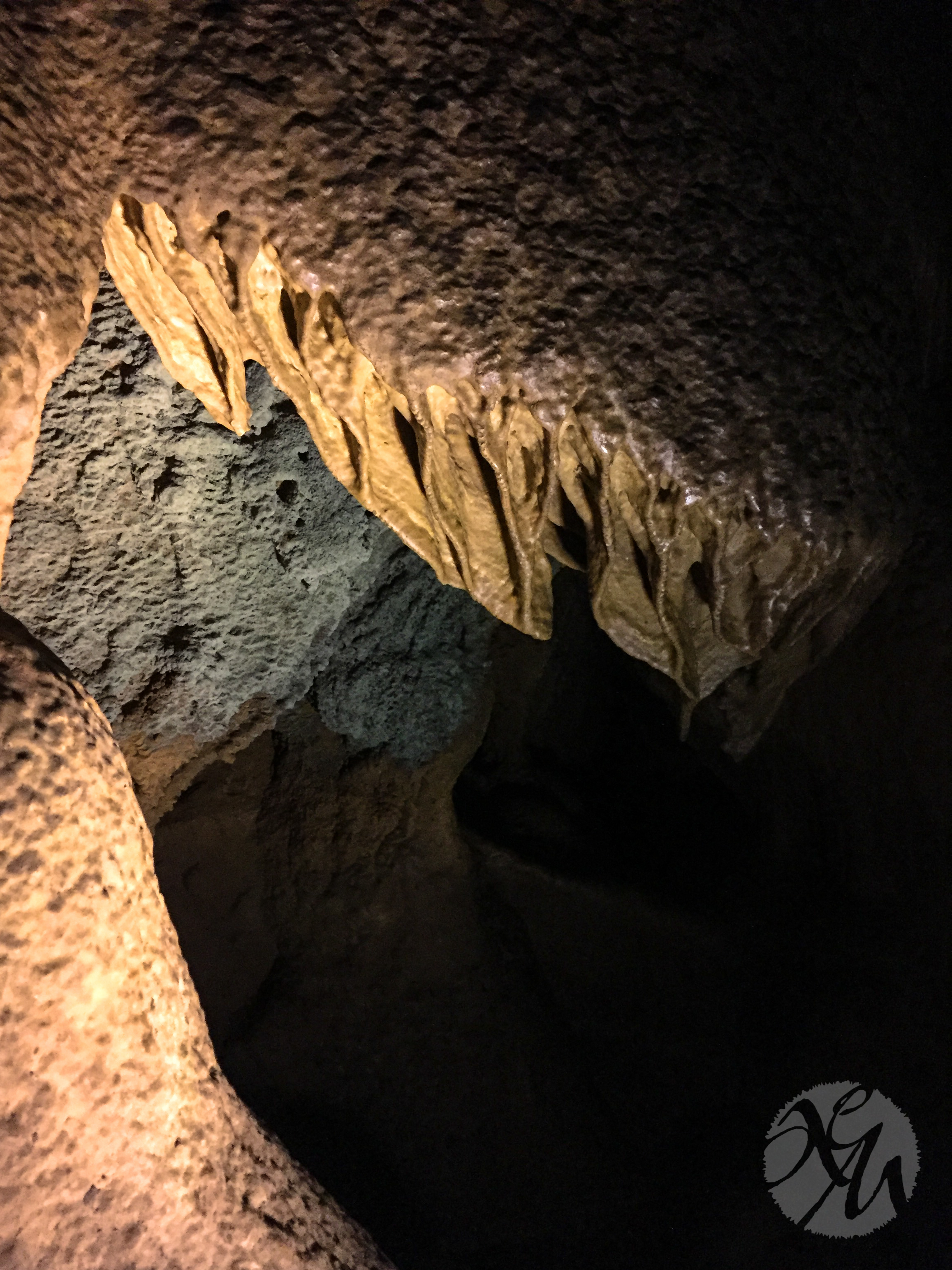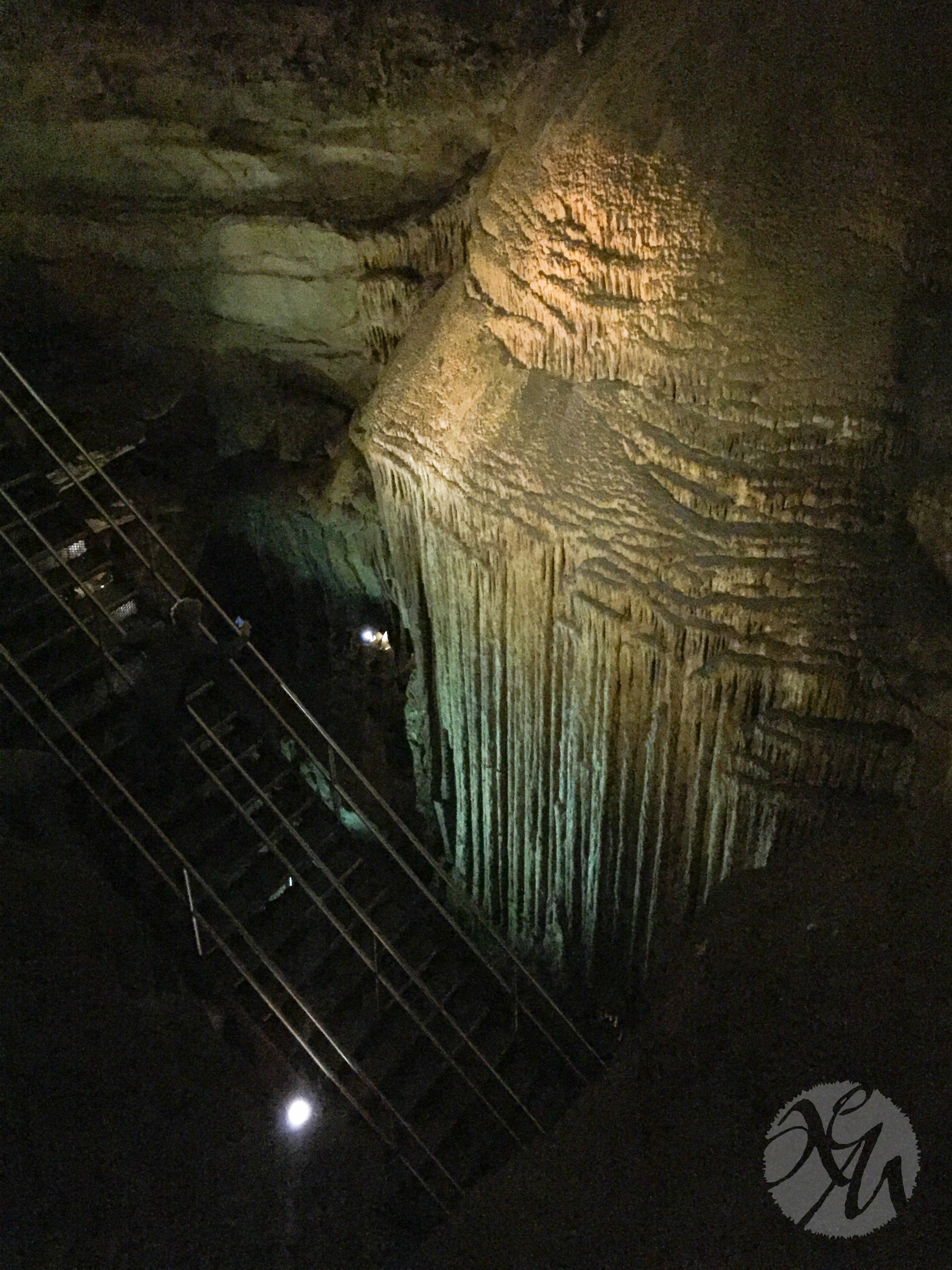Week 13: A ‘Very Strenuous’ Venture Underground: Mammoth Cave Road Trip (Part 3) [Score +9]
Our grand finale at Mammoth Cave National Park: seeing inside the cave itself, what we’d been waiting and planning for for months.
The only way to enter the cave is while on a paid, guided tour with a Park Ranger. Each tour has a limited number of tickets, and the tour offerings differ each season. Considering the list of options for the spring season on the park’s website and trying to decide what to do was a bit mystifying. Do we go for two shorter tours? One long one? Multiple tours across two days? Or after one day of being underground, would we have had our fill of the cave?
In the end, we chose one long tour: the Grand Avenue. Four miles of cave trail covered in four hours. This tour included sections covered on two of the other shorter tours, so it was an effective use of our time and ticket money, too.
But really, a big reason we chose it (being the intrepid women we are) is because the level of difficulty was listed as Very Strenuous. We both figured that what the cautious people at the National Park Service deemed as Very Strenuous for the average tourist would be what the two of us would deem as Barely Moderate.
One other tour was offered that met the Extremely Strenuous criteria, aptly named the Wild Cave Tour. On this one, you don special outerwear and face your claustrophobic limits with some tight squeezes through impossible-looking holes (I saw one myself and didn’t think there was any way I’d be able to fit through it). I wasn’t feeling quite intrepid enough for the Wild tour (yet), so staying upright while getting a Very Strenuous adventure and some exercise sounded just about right for our first time in the cave.
At go-time on Monday morning, after an introductory and cautionary welcome from our Ranger guide—who once again emphasized the strenuous nature of this tour—we boarded two buses along with 76 other fellow visitors and traveled to our starting point, the Carmichael Entrance.
This is something I didn’t realize about the Mammoth Cave system until I had a map of the park in my hand and physically found myself at a nondescript entrance: the Historic Entrance, which Gina and I hiked by on Sunday is not the only entrance to the cave system. It’s the one you see advertised, and it’s certainly grand. If I’d really given it thought, I’d have of course realized that they wouldn’t send thousands of tourists into the cave each year with just one entrance and exit. But there’s a difference between a grand entrance and an emergency exit.
The Carmichael Entrance to Mammoth Cave, one of several entrances and exits in addition to the best-known Historic Entrance.
So when we were dropped off at the Carmichael Entrance, I was actually surprised and admittedly a little disappointed to be filing down a long stairway through a set of doors instead of the gaping, chilling Historic Entrance.
That disappointment didn’t last long. While we were waiting our turn on the stairway, a friendly and enthusiastic woman—a local in the area—behind us in line asked if this was our first visit. When we confirmed it was, she got very excited for us to have our First Experience, because she herself had visited the cave numerous times and was happy to be accompanying some out-of-town relatives that day on their own first trip. Her enthusiasm was contagious and reassuring for me, as well, in part because I’d chatted with an acquaintance at home who was also from western Kentucky and didn’t think Mammoth Cave was anything to really celebrate. “It’s just big,” was as descriptive and excited as that woman could get. Gee, thanks. It’s never fun to have someone sprinkle rain on your adventure before you’ve even started.
But our fellow tour-mate made up for that lack of interest by offering spades of it. Through the course of our conversation, it became apparent that she really did know a lot about the history of the area and the cave. When we remarked on her knowledge, she gave a glowing review of a nonfiction book that we could find in the gift shop afterward: The Longest Cave by Roger W. Brucker and Richard A. Watson, Ph.D.
I’ve given my share of glowing book reviews and fervent wishes for friends to read one of my favorites, and this woman exuded that same level of passion and fondness for this niche book about the exploration and efforts in the 1950s, ‘60s, and ‘70s by cavers to connect the caves of nearby Flint Ridge to Mammoth Cave and confirm it as the longest cave system in the world. She said she’d read it multiple times already, could hardly put it down each time, and intended to go home after our tour and read it again. (How could I ignore such a passionate recommendation? Gina and I each bought it in the gift shop afterward to take home with us.)
A wide, smooth section of trail not far into the cave via the Carmichael Entrance.
Finally, our time had come to enter the cave, and we descended down, down, down dozens of endless steps into the cool darkness. The cave consistently has an air temperature between 54 and 58 degrees Fahrenheit, and the humidity was around 80%. The trail throughout the tour was smooth and wide, wide enough for perhaps five or six people to walk side by side at times, but narrow enough to allow just single-file passing in others. For most of our tour, the cave was dry, and crusty gypsum formations were the most notable geological features.
Like trails and roadways on the surface above, each path and notable landmark in the cave has a name: Cleaveland Avenue. The Snowball Room. Mary’s Vineyard. Thorpe’s Pit. Mount McKinley. Grand Canyon. Frozen Niagra.
The Snowball Room, named for the snowball-sized gypsum formations covering the ceiling, in decades past served as a mid-tour lunch stop for guests. Mary’s Vineyard is characterized by grape-like clusters of limestone deposits.
Civil War-era graffiti on the walls of the Snowball Room, which was used as a dining hall for tours in decades past. Much of the graffiti was created using the soot from candles and lamps, but the "Cofland's Tonic" you see in this photo used some kind of paint. It was a kind of snake oil.
Mount McKinley marked one of the three “big hills” that give the Grand Avenue tour its Very Strenuous rating. It was a steep hill pitched at perhaps 30 degrees or so, and using the handrails was a must, but what surprised me most was that the climb hadn’t been fitted with stairs. Instead, much of the trail remained smooth, flat rock just as the horizontal trail had been.
Although Gina and I didn’t find the climb to be particularly strenuous, seeing several other people struggle made me understand why the tour truly was rated as so challenging. It’s easy to take your own fitness and health for granted if it’s what you live with every day.
Climbing Mount McKinley and passing through the Grand Canyon, two of the largest “rooms” on our tour, felt like what I’d expected of Mammoth Cave: big, cavernous, spacious caves.


My other favorite and anticipated feature was at the Frozen Niagara end of the tour. This was the wet end of the cave, where water regularly drips, flows, and continues to mold the cave with evolving stalactites, stalagmites, and other formations. (See a couple photos to the right.) As a result, if you visit again in 15 years, you’re likely to see changes in the cave’s contours as the water molds it over time.
After four hours below ground, we resurfaced into bright sunshine and the lush green park. But after our short bus ride back to the Visitor’s Center, there was one more critical activity we had to do: cleanse our shoes of any spores from the devastating white nose fungus.
Fortunately for humans, the white-nose syndrome is not something we can contract. Unfortunately for both us and the bat population, it is wiping out whole populations of bats and spreading alarmingly fast from the northeastern corner of the U.S. into the central states. When I say it’s wiping out populations, I’m seriously talking about 80-90% of bats in the affected area. Many people find bats to be creepy or scary and don’t want them around, but they absolutely feast on mosquitoes every night. I would much rather have a family of bats living nearby than a horde of mosquitoes!
Because we’d remained on our feet throughout the tour and hadn’t crawled through the cave, all we had to cleanse were the soles of our shoes. The process was deceptively simple: after exiting the bus, we walked across a large, black, squishy mat saturated with a solution of water and Woolite. The white-nose syndrome is already killing off 90% of Mammoth Cave’s bats, so it’s too late to help the situation with this simple treatment there, but we were told that by walking through this cleansing solution, it would help to prevent us spreading it to other uninfected caves if we were to wear the same pair of shoes on a later trip.
Thankfully our drive back to Indianapolis after our tour was uneventful, unlike our trip to Kentucky a couple days earlier. And looking afterward at the larger map of the publicly toured area of the cave, I see landmarks and areas marked that I would love to see on another trip. I’m glad I took the chance to see an amazing park so close to home, and I’m looking forward to doing more of that soon.
Score:
- Did something outside my routine: +1
- Left the house: +1
- Did something entirely new: +1
- Activity benefits my health/wellbeing: +1
- Burned real calories (so I got some exercise): +1
- Had a conversation with a stranger of at least 30 seconds: +2
- Had a conversation with a stranger beyond basics (i.e., work, hometown, what’s your dog’s name): +2

![Week 13: A ‘Very Strenuous’ Venture Underground: Mammoth Cave Road Trip (Part 3) [Score +9]](https://images.squarespace-cdn.com/content/v1/58b4c7cc20099e8b54a9ad11/1497143180971-J253APZMNW2BPTMRF0K2/MammothCave-56-aem.jpg)
![Week 14: An Epic Ride and a Wink from the Universe [Score +10]](https://images.squarespace-cdn.com/content/v1/58b4c7cc20099e8b54a9ad11/1497485482206-1G82DV3KQ650ZYM16JGK/BORide-28-aem.jpg)
![Week 13: Road Trip! We Made it to Mammoth Cave (Part 2) [Score +7]](https://images.squarespace-cdn.com/content/v1/58b4c7cc20099e8b54a9ad11/1496575428770-GMA66584UODO44BRBTIZ/MammothCaveGinas-09-3-header-aem.jpg)
![Week 12: Road Trip! Part 1 [Score +3]](https://images.squarespace-cdn.com/content/v1/58b4c7cc20099e8b54a9ad11/1495933239059-9WGD2U08GL20HUZJUN7Y/MammothCave-29-aem.jpg)
![Week 34: A Hike Near Home, Courtesy of Meetup [Score +14]](https://images.squarespace-cdn.com/content/v1/58b4c7cc20099e8b54a9ad11/1511748004081-7GTWP63WS08OXYGELS1B/MeetupHike-114-aem.jpg)